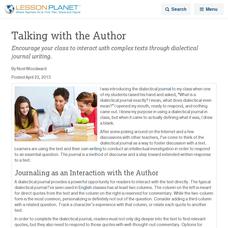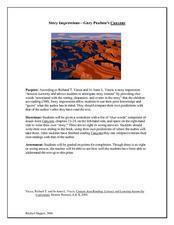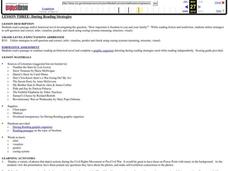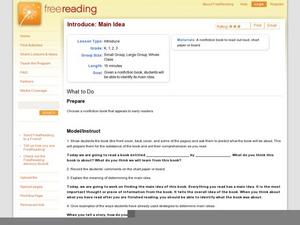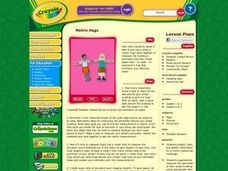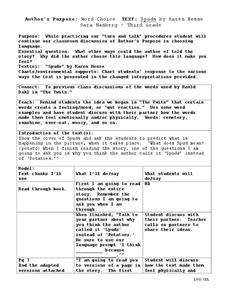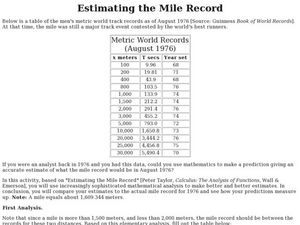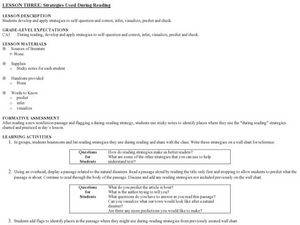Curated OER
Talking with the Author
Encourage your class to interact with complex texts through dialectical journal writing.
Curated OER
A Hidden Beauty
Expose the beautiful mystery of bulbs as young botanists learn all about these fascinating plants. They glean information from a short text before observing actual bulbs (consider an onion), and comparing their findings with predictions....
Curated OER
The Internet of Things: IoT
How has the Internet of Things affected our lives? Scholars examine the massive influence of mobile devices in this analysis activity, which begins with a seven-minute documentary clip. They also read a New York Times article (linked)...
Polk Bros Foundation
Preview Reading
Scanning a text before getting started is a reading strategy that your pupils can use to get a general idea about a text before diving in. Give some direction to their scanning with a worksheet that includes items to check for and space...
Curated OER
Story Impressions-Gary Paulsen's Canyons
What is a story impression? Learn about the strategy with the first page of this two-page resource. Before reaching chapters 21-24 in Canyons, readers use a list of words (taken from these chapters) to predict what is going to happen....
Curated OER
During Reading Strategies
"How important is freedom to you and your family?" The guiding question becomes much more powerful after your class reads and responds to a passage from a historical novel. While reading the passage, they complete a graphic organizer...
Curated OER
Introduce: Main Idea
Begin exploring main idea in a text by telling the class an interesting story. Can they recall the main idea after you finish? What clues told them this was it? Explain that you will apply this concept as you read a nonfiction book....
Curated OER
Introduce: Cause and Effect
Introduce beginning readers to cause and effect in a story by exploring it together. Learners make predictions about a book based on its cover, title, and a brief flip through the pages. They listen to an explanation of cause and...
Curated OER
Goldilocks and the Three Bears
Explore storyboards with your pre-reader using the familiar story "Goldilocks and the Three Bears." They look at pictures as you read the captions in a comic book style. At the end, they try to finish the story based on a resolution...
Curated OER
How Far Can You Jump?
Students estimate the distance of student's broad jumps. This activity can take place in the block center with a small group of students. They are explained that they are going to jump from a starting point (marked with the masking...
Curated OER
Reading Practice: Boris the Brainiest Baby
Boris is the smartest baby around! Beginning readers can use this short story excerpt to practice reading comprehension and fiction elements. They read the story and then discuss what they think he will do next. Scholars create an...
Curated OER
Sequence, Predict, Infer: Pink and Say
Practice sequencing with your 2nd graders via Patricia Polacco's Civil War book Pink and Say. Begin with a blindfold and a bag of mystery items. Connect their use of clues to identify what they can't see with the skill of making...
Curated OER
Collecting Data to Learn About the People Around You
Human graphs, anyone? Did you eat fruit today? What is your favorite costume? Have your K – 6 learners graph the responses. Early elementary grades may count and compare while upper grades compare responses of different groups or make...
Curated OER
Mixed Up Chameleon
Students discover facts about chameleons. In this adaptations lesson plan, students read a book about chameleons and discuss the adaptations they have to survive. Students also discuss predator and prey of the chameleon. Students...
Curated OER
Similarity: Instructional
For this similarity worksheet, students solve and complete 7 different problems that include determining various dimensions of mirrors shown. First, they find the length of the diagonal of the large mirror in the diagram. Then, students...
Curated OER
Water Cycle
Identify and interpret the earth's different water sources. Third and fourth graders describe and demonstrate the process of the water cycle, make a model of its two main parts, and predict and infer to answer questions about the...
Curated OER
Metric Hugs
Students predict, plan, and gather information for a metric measuring challenge. They cooperatively measure the perimeter of their school building using appropriate tools according to a plan they devise together. Students create...
Curated OER
One Hundred Things
Learners practice estimating by handling items in groups of ten. They visualize how much space 100 items, such as pennies, peas, or beans, will take up after holding 10 of them. Students measure the difference in volume between 10...
Curated OER
Graphing
In this graphing worksheet, students solve and graph 10 different problems that include determining various coordinates and the slope. First, they use the table to write the x and y coordinates for each point on the graphs. Then,...
Curated OER
Making Predictions:
Pupils of all ages practice making predictions about what will happen next in a fairy tale as the teacher reads it aloud. They demonstrate how to support their predictions with information and facts from the story.
Curated OER
Word Purpose
Third graders chunk text while reading it. In this language arts lesson, 3rd graders determine the author's purpose for calling certain things the names they are called like spuds for potatoes. Students discuss how words affect the...
Curated OER
Weather Watchers
Second graders discuss what weather is and list words that can be used to describe weather. In this science lesson, 2nd graders develop symbols for each type of weather and record the weather for two weeks at the same time and the same...
Curated OER
Estimating the Mile Record
In this estimating the mile record, students examine given data. They use create a box-and-whisker plot to determine the upper and lower quartiles of the data. This one-page worksheet contains 1 multi-step problems.
Curated OER
Strategies Used During Reading
Students try a variety of reading strategies. For this reading strategy lesson, students read a nonfiction passage and put Post -Its to mark the spots where they are using a reading strategy. They focus on inferring, predicting,...


